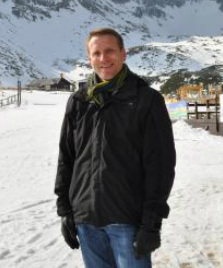Collaborators
|
Dr. Philip Boyd
University of Tasmania (AUS) Dr. Boyd and Dr. Nunn collaborate on the biogeochemistry of iron and its effects on algal productivity. More recently we have been examining the proteomic alterations to diatoms at mid-exponential phase and stationary phase under various nutrient conditions to search for bloom export biomarkers. |
|
Steven Roberts
University of Washington Kenneth K. Chew Endowed Professor in the School of Aquatic and Fishery Sciences at the University of Washington where his research focuses on characterizing physiological responses of marine organisms to environmental change. Research in the Roberts lab focuses on characterizing physiological responses of marine organisms to environmental change. Using integrative approaches they strive to examine impacts and adaptive potential from the nucleotide to organismal level. A core component of this includes investigating the functional relationship of genetics, epigenetics, and transcription. |
|
Dr. Robert Morris University of Washington Marine Bacteria and Archaea play critical roles in global nutrient cycles by incorporating and redistributing dissolved organic matter and inorganic nutrients in the oceans. The collaborations between the Morris and Nunn lab focuses on understanding how bacteria and archea control the flow of nutrients (e.g. C, N, P, S...etc) in the marine ecosystem by examining community protein expression. Since proteins are the biochemical machines of a cell, looking at relative expression levels in different parts of the ocean, we can investigate which bacteria are involved in the metabolism of the various nutrients. |
|
Dr. Julia Kubanek
Georgia Institute of Technology Seasonal blooms of the red tide dinoflagellate, Karenia brevis, can form almost monospecifically in the Gulf of Mexico with ecosystem-wide effects. K. brevis produces brevetoxins, polyketide natural products which act as potent neurotoxins in vertebrates, causing massive fish kills and poisoning humans through intoxicated shellfish. Red tides also have an economic impact, due to costs associated with lowered fishery production, health care and decreased tourism during blooms. Despite their importance, the role of brevetoxins and other chemical cues in the plankton ecology is not well understood. Research in our group focuses on the ecological roles of chemical signals in Karenia brevis blooms. |
|
Dr. Robert H. Richmond
University of Hawai'i at Monoa Bob's research interests are in the area of marine conservation biology, with a focus on coral reefs. Bob's research programs include studies of coral reproductive biology, ecotoxicology, coral reef ecology, the impacts of climate change and bridging sound science to policy development and implementation. He has spent the majority of his professional career studying coral reefs in Micronesia, Hawaiʻi, Japan, Central America, the Galapagos Islands and the Caribbean. Together with the Nunn lab, we are examining anthropogenic effects on Hawaiian corals. |
|
Dr. David Goodlett
University of Maryland Since 2004, we have been collaborating on projects that bring the latest proteomics technology to the marine chemistry community. Projects have included the extraction of proteins from >1000 year old sediments to identifying metabolic strategies of organisms under a variety of conditions. More recently, we are tackling lipid A biochemistry of bacteria living in subzero temperatures, such as the Arctic and Antarctica. |
|
Dr. Karen Junge
University of Washington Applied Physics Lab-Polar Sciences Together, we are exploring the relationship between deep-freeze bacterial activity, proteomics, and polymers to try and decipher how life under extreme conditions survives and flourishes. We hope that this provides critical insight into the various bacteria in ice formations here on Earth, the atmosphere, or elsewhere in the universe. |








